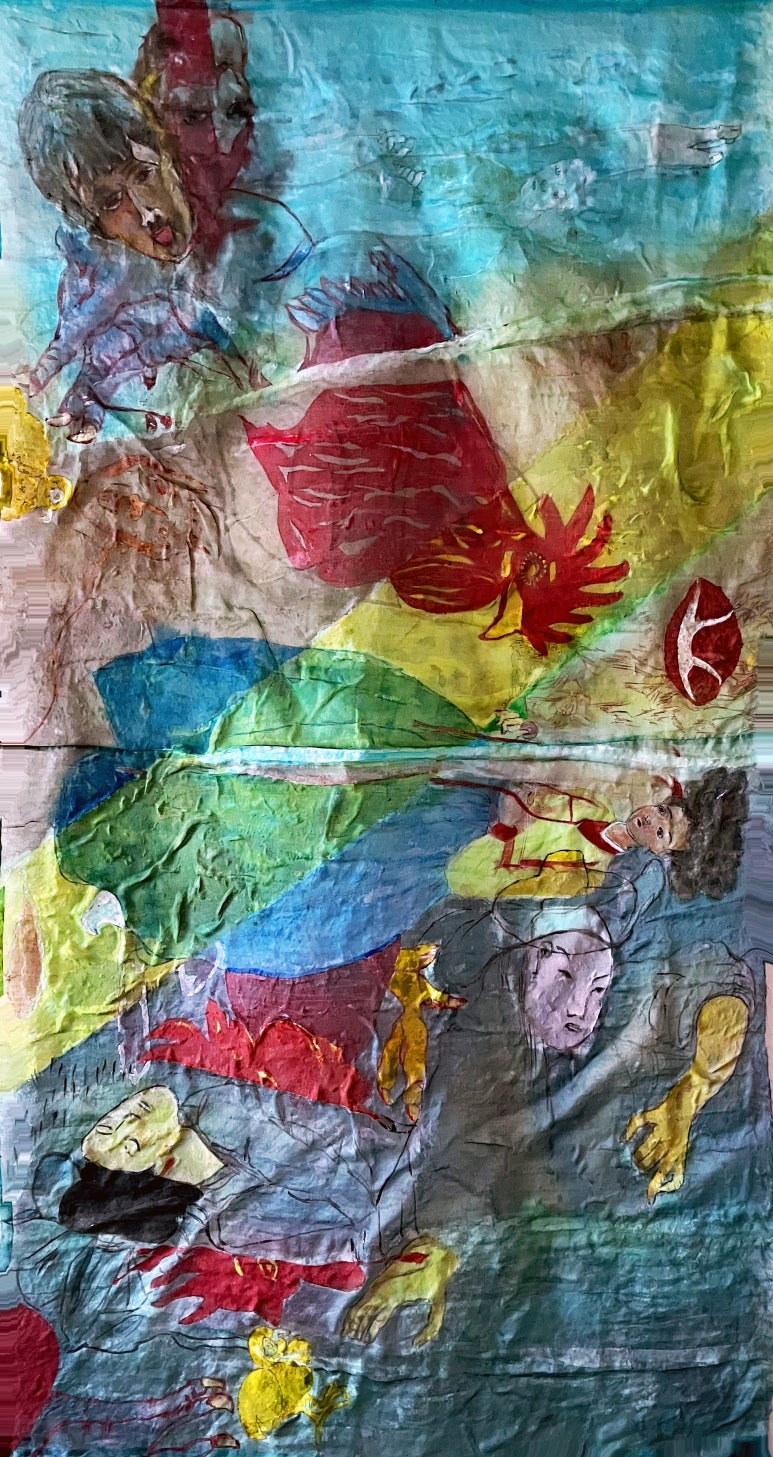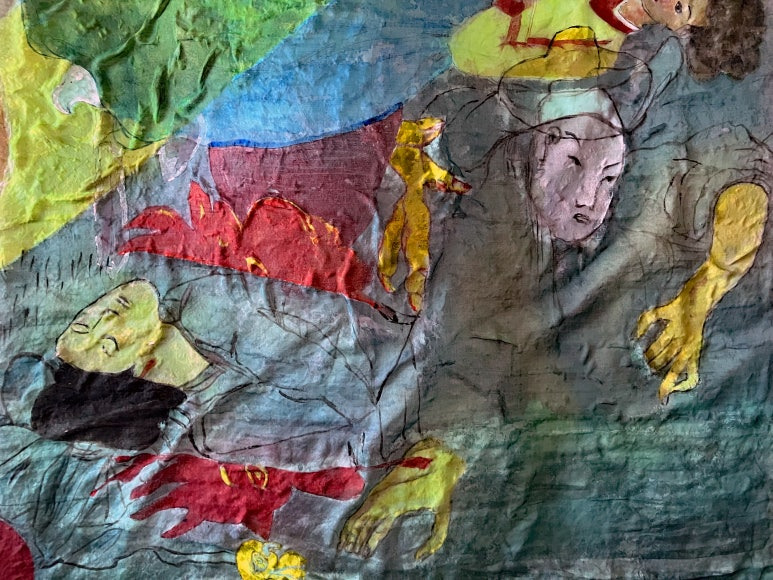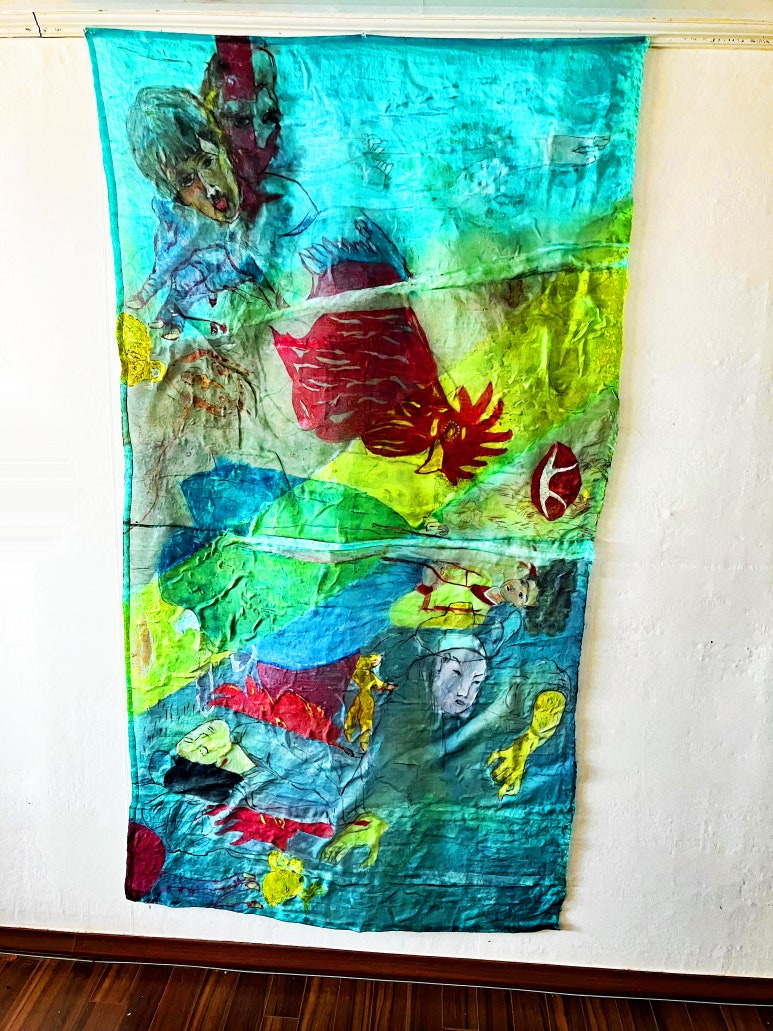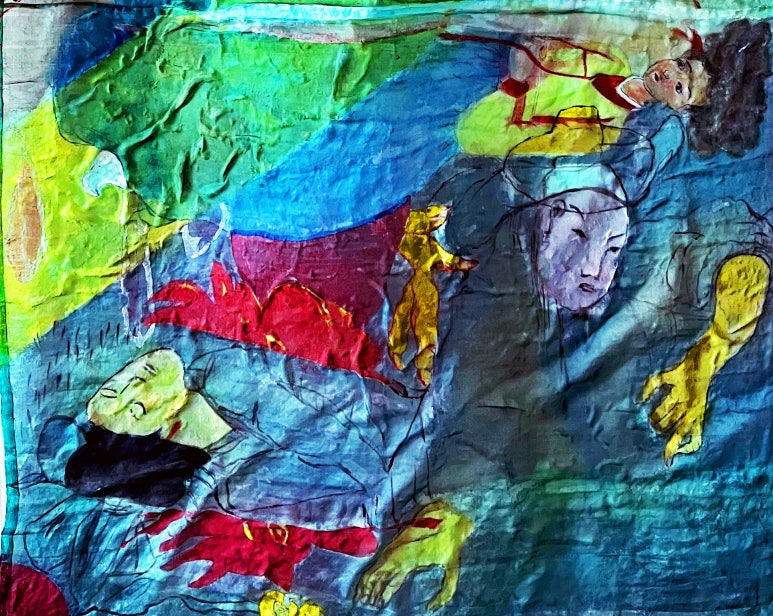미술평론 뉴스-신작읽기/ Art Review News- Reading New Works: 현대미술 회화 디자인 [11] 개념적 의미 구조로서 욕망 개념의 추상화 디자인 프로세스, The artwork posted on Facebook: Modern Art Artist Louis Choi Chul-joo Conceptual Abstract Work Criticism: Contemporary Art Critic Louis Choi Chul-joo's Contemporary Art - Conceptual Art, Abstract Art, Pop Art, Cartoon Criticism/ Louis Choi Chul-joo Abstract Art work ( https://opensea.io/Louisland ) review:
가역적 빛의 음영이 만든 기호적 표현 문법 Louis Chul-joo Choi, morning glory 2025-3-Symbolic representation grammar generated by reversible shades of light, 114X210cm, acrylic and composite materials on cloth, 2025

Louis Chul-joo Choi, morning glory 2025-3-Symbolic representation grammar generated by reversible shades of light, 114X210cm, acrylic and composite materials on cloth, 2025
가역적 빛의 음영이 만든 기호적 표현 문법
욕망 개념에 미적 표현의 결핍은 다른 사람들의 무의식적인 욕망 개념에 표현이 존재하는 것과 달리 많은 실제 대상과 공시성을 가진다.
따라서, 빛의 가역적 그림자에 의해 만들어진 문법적으로 표현된 추상화에서 상대방의 무의식적인 욕망을 동시에 표현하는 것과 달리, 언어적 표현으로서 미적 구조를 추구하는 추상적 표현은 실제 이미지에서 드러난다.
이것은 기호적인 문법적 오브제에 따른 의도적인 표현이며, 타자가 참여할 수 있도록 하는 추상적인 경험으로 표현된다.
욕망의 개념을 상징하는 표현 이미지, 즉 회화적 표현은 무의식적인 언어적 의미와 추상적 현실 사이의 표현 움직임을 나타내는 실재 이미지에서 욕망의 개념이 결여되었을 때 빛의 가역적인 그림자에 의해 기호적인 미적 구조로 만들어진 추상적 표현이다.
최철주의 욕망 구조에서, 가역적인 빛의 음영 속에서 기호적 문법은 현상적 이미지의 원인을 사건 이미지의 시선 방향에 있는 선 공간에서 타자의 무의식적인 욕망의 징후로서 반복하는 언어적 이미지입니다.
이것은 타자의 욕망 개념의 원형적 오브제에 의해 빛에 의해 오브제가 가려진 후 생성되는 음영적 욕망 이미지입니다. 그 이미지는 상상계에서 언어적 의미와 추상 논리를 문법적 표현으로 분석하는 수학적 함수로 나뉩니다. 이는 이원적 관계이며, 욕망의 개념은 실제 이미지에 해당하는 기호적 오브제에 표현적 욕망 값을 적용하여 실제 이미지와 동일시한다. 따라서 언어적 의미와 추상 논리를 상상계의 문법적 표현으로 분석하는 수학적 함수로서, 표현적 욕망 가치는 실제 이미지에 해당하는 기호적 오브제에 적용되며, 기호적 변수로서의 욕망 가치는 추상적 욕망 체계에서 욕망 기호의 실제 이미지 연쇄로 디자인된 표현적 의미이다..

표현적 의미로서 조선시대 소외된 여인의 춘화는 풍속화에서 욕망값이 큰 구성으로 버드나무 등 사계절의 자연을 배경으로 한 신윤복 건곤일회첩(乾坤一會帖) 화풍의 에로틱한 이미지다. 이것은 성적 행위를 상상하는 표현적 추상성에 대한 이중적 관계로서 윤리적 풍속화를 넘어서 또 다른 상징으로 분열한 모방적 욕망 디자인을 결합한 본질적 이미지로서의 성적 표현 즉 결핍된 욕망을 보인다.
따라서 표현적 이미지는 사건 이미지의 조각된 욕망이 타자의 욕망 구조에서 가려지기 때문에 현실의 이미지를 무의식적인 욕망 구조로 구성하여 욕망의 불투명한 원인으로 인한 욕망 행동에 의해 차단되어 만들어진 그림자입니다.
치마에 겹쳐진 부분을 생략한 기호 이미지가 표현적 이미지로서 실재 이미지를 대리할때 사실적 구조로서 추상화를 이룬다. 이것은 표현적 이미지가 욕망 개념을 추상한 이미지와 동일한 이미지의 문법적 의미구조를 사용했기 때문이다.
최철주 욕망 개념에서 빛의 고도와 방향이 명시되지 않는 가역적 빛은 시간성에 따른 존재로서 문법처럼 실재를 구성하는 문법적 이미지를 만드는 원인이 된다. 표현의 문법적 실재의 오브제로서 사건 이미지의 외상적 이미지는 가역적 빛을 존재로서 실재 이미지로 대치되면서 욕망 개념을 말한다. 이 같은 욕망의 공식 <D(I...I')d=I(D...D'i)i>을 통해 오브제로서 사건 이미지의 추상적 욕망 개념에서 분열한 주체로서 의미를 출현한다.
이것은 욕망 개념의 언어적 의미를 대리하는 실재를 이미지로 표상하여서 추상적 욕망을 실제화한 욕망 오브제다.
따라서 상징적 효과 이미지의 조합으로서 언어적 의미가 욕망을 나타내고, 공적 기능으로서 언어적 은유가 전체를 나타내는 표현적 이미지와 상징적 문법 기능으로서 욕망 구조를 구성하는 스케치에 의해 생성된 표현적 이미지가 욕망의 결과를 형성하는 장치가 최철주의 욕망 개념 추상디자인 프로세스 다.
표현적 기호 이미지는 문법적인 문장 해석과 무관한 단어를 상징하는 추상적 의미를 사건 이미지로 보인다. 그러나 문법은 추상적인 비언어적 행위의 논리적 의미를 부여한다. 따라서 욕망의 개념을 문법적 언어 구조로 해석하기 위해 언어적 의미의 추상적 상징 패턴을 반복적으로 디자인하고, 욕망의 개념과 동일한 이미지를 의식과 개념 디자인으로 나누는 언어적 의미와 상징적 이미지로 식별한다.
또한, 식별된 문법에서 욕망 개념의 언어적 의미와 상징적 이미지가 욕망 객체로 명확하게 정의될 때, 존재의 이미지는 놀랍게도 빛에 의해 드러난다.

시간성에서 빛의 광점에서부터 가역적 빛으로서 오브제로서 질료를 실재 이미지로 연출한다.
사건의 이미지를 반영하는 연못에서 추상적인 욕망의 개념은 현실 세계의 다른 사람들의 욕망을 거울처럼 반영하여 표현됩니다.
최철주의 욕망 개념, 즉 현대 미술이 등장하는데, 형이상학적 철학적 빛에서 강조된 언어적 의미의 개념과 충돌하는 그림이 인공 조명으로 극적인 사건 이미지를 만들어낸다.
사건의 이미지를 반영하는 연못에서 추상적인 욕망의 개념은 현실 세계의 다른 사람들의 욕망을 거울처럼 반영하여 표현된다. 최철주 작가의 추상적인 욕망 개념, 즉 형이상학적 철학적 관점에서 현대 미술이 등장하고 강조되는 언어적 의미 개념과 충돌하는 그림들은 인공 조명과 함께 극적인 사건 이미지를 만들어낸다. 그는 어두운 현존 공간에서 시간성에 중첩되는 가역적 빛의 음영으로 하얀 빛에서 흰색을 공유하는 공간의 오브제로서 여러개의 사건 이미지를 각각 몽타주처럼 조명한다.
이것은 회화에서 18세기 유물론과는 달리 물리적 지각이 아닌 욕망적 추상으로 자아를 넘어서 타자의 욕망을 오브제로서 사건 이미지를 결핍된 욕망의 주체로 해석한다.

이원론적 오브제의 상상적 기호표현으로서 표현적 욕망 개념과 표현 행위로서 사건 이미지의 간극을 언어적 의미로서 오브제의 주체와 실재를 동일시한다. 여기서 주체는 기호표현의 영향으로 욕망 개념의 오브제로서 공간 구성의 원리에 맞추어 실재로서 추상 이미지를 연출하여서 결핍된 욕망을 의미한다. 실재로서 이미지의 추상은 오브제의 색을 빛의 반사로 인식하지 않고 정해진 오브제의 상징색이 빛의 조명으로 음폐되어서 결핍된 구조에서의 오브제를 상징하는 언어적 의미에서 결핍된 이미지로서의 실재를 동일한 구조로 해석한다. 여기서 사물의 이미지가 말하는 욕망의 개념을 사건 이미지로 연출하는 것이 최철주의 욕망 개념 추상디자인 프로세스 다. 이것은 시각 정보가 추상적인 방식이 아닌 가역적인 빛의 그림자로 인식되는 오브제의 상징색을 무의식적으로 경험하면서 욕망의 개념을 구성이다. 따라서 경험의 방식으로 오브제의 언어적 의미에서 오브제의 상징색을 이미지 색으로 파악하기 위해 최철주 욕망 공식을 반복적으로 디자인한다.
오브제의 상징색은 대상의 구조를 언어적 의미로서 형이상적으로 인식하여서 실재를 구성하는 미적 역할을 한다. 실재를 미적 구조로 표현하는 것은 욕망 체계를 관리하는 추상적인 개념이 언어적 의미로 정의된 것으로 색상으로 색으로 표현하는 추상적 회화 방식이다,
여기서 특정 존재로서의 오브제는 추상적인 욕망을 추구하는 과정에서 실재를 상징하는 언어적 의미의 이미지이며, 색과 실존적 가치를 디자인하는 오브제의 욕망 구조가 결여된 개념을 충족시켜 욕망을 충족시키는 향유적 실재 이미지다.
향유적 실재 구조는 대상의 주체와 욕망의 개념 사이의 언어적 의미 관계를 나타내며, 주체는 가역적인 빛의 그림자처럼 실재 이미지의 영향을 받는다.
따라서 인식된 색상으로 욕망을 표현하는 특정 객체는 가역적인 빛의 음영으로 추상화된 합리적인 욕망의 실제 이미지로 일반화되는 추상화로 변환되며, 상대방의 욕망은 일관된 의미에서 쾌락을 경험하는 선 공간에 대한 욕망의 실재를 꾸민다./글. 현대 미술평론가 최철주 (문화디자인박사)

Louis Chul-joo Choi, morning glory 2025-3-Symbolic representation grammar generated by reversible shades of light, 114X210cm, acrylic and composite materials on cloth, 2025
Symbolic representation grammar generated by reversible shades of light
The lack of aesthetic expression in the concept of desire has many real objects and expressions, unlike the expression in other people's unconscious concept of desire.
Thus, unlike simultaneous expression of the other person's unconscious desire in grammatical expression abstractions created by reversible shadows of light, abstract expressions pursuing aesthetic structures as linguistic expressions are revealed in real images. This is an intentional representation according to symbolic grammatical objects, and is represented as an abstract experience that allows others to participate.
An expression image that symbolizes the concept of desire, or a pictorial representation, is an abstract expression made into a symbolic aesthetic structure by the reversible shadow of light when the concept of desire is lacking in the real image that represents the movement of expression between unconscious linguistic meaning and abstract reality.
In Choi Chul-joo's desire structure, symbolic grammar in a reversible shade of light is a verbal image that repeats the cause of the phenomenal image as a sign of the unconscious desire of the other in the line space in the gaze direction of the event image.
This is a shadowy desire image created after the object is hidden by light by the circular object of the concept of desire of the other.
The image is divided into a mathematical function that analyzes linguistic meaning and abstract logic as grammatical expressions in the imagination world. This is a binary relationship, and the concept of desire is the same as the real image by applying the expressive desire value to a symbolic object corresponding to the real image. Thus, as a mathematical function that analyzes linguistic meaning and abstract logic as grammatical expressions in imagination, expressive desire values are applied to symbolic objects corresponding to real images, and desire values as symbolic variables become expressive meanings designed as a chain of real images of desire symbols in abstract desire systems.

In an expressive sense, the pornography of a woman alienated from the Joseon Dynasty is an erotic image in the style of a book called Shin Yoon-bok's Gyeon-Gon-Il-Hoe (乾坤一會帖) against the backdrop of four seasons such as willow trees, and has a high desire value in genre painting. This is a dual relationship with expressive abstraction that imagines sexual behavior, and it shows sexual expression, that is, a lack of desire, as an essential image that combines imitative desire design divided into another symbol beyond ethical genre painting.
Therefore, the expressive image is a shadow created by being blocked by the desire behavior caused by the opaque cause of desire by constructing the image of reality as an unconscious desire structure because the sculpted desire of the event image is obscured from the desire structure of the other.
When a symbolic image in which the overlapping part of the skirt is omitted represents the real image as an expressive image, it forms an abstraction as a realistic structure. This is because the expressive image used the same grammatical semantic structure as the image that abstracted the concept of desire.
In Choi Chul-joo's concept of desire, reversible light, whose altitude and direction of light are not specified, is a being according to temporality and is the cause of creating a grammatical image that constitutes reality like grammar. The traumatic image of an event image as an object of the grammatical substance of an expression refers to the concept of desire to replace reversible light with real existence. Through Choi's desire formula <D(I am...)d=I(D...D'I)i>, meaning appears as the meaning of a separate subject in the abstract concept of desire as an object in the event image.
This is a desire object that realizes abstract desire by representing reality that represents the linguistic meaning of the concept of desire as an image.
Therefore, Choi Chul-joo's desire concept abstract design process is a device in which the expressive image, in which the verbal meaning represents desire as a combination of symbolic effect images and the verbal metaphor represents the whole as a public function, and the expressive image created by the sketch, which constitutes the desire structure as a symbolic grammatical function, forms the result of desire.
Representation images show abstract meanings that represent words that are not related to grammatical sentence interpretation as event images; however, grammar gives logical meaning of abstract nonverbal behavior.
Thus, to interpret the concept of desire as a grammatical linguistic structure, we repeatedly design abstract symbolic patterns of linguistic meaning, and identify images identical to the concept of desire as linguistic and symbolic images that divide them into consciousness and conceptual design.
In addition, when the linguistic meaning of the concept of desire and the symbolic image are clearly defined as desire objects in the identified grammar, the image of existence is surprisingly revealed by light.
As a reversible light from the point of light in temporality, the material is produced as a real image as an object.
In a pond reflecting the image of an event, the concept of abstract desire is expressed by reflecting the desires of others in the real world like a mirror.
Choi Chul-joo's concept of desire, modern art, emerges, in which a painting that collides with the concept of the linguistic meaning emphasized in metaphysical philosophical light creates a dramatic event image with artificial lighting.
In a pond that reflects the image of an event, the concept of abstract desire is expressed by reflecting the desires of others in the real world like a mirror.
Paintings that conflict with Choi Chul-joo's abstract concept of desire, that is, the linguistic concept of meaning in which modern art emerges and is emphasized from a metaphysical philosophical point of view, produce dramatic event images with artificial lighting.
In dark conventional space, he illuminates several event images like montage as objects that share reversible shades of light and white light overlapping with temporality.
Unlike 18th-century materialism in painting, this interprets the desire of the other as an object beyond the self as a desire abstract rather than a physical perception.
As an imaginary symbolic expression of a dualistic object, the gap between the concept of expressive desire and the image of an event as an act of expression equates the subject and reality of the object as a linguistic meaning. Here, the subject refers to what is the lack of desire by directing an abstract image as a reality in accordance with the principle of spatial composition as an object of the concept of desire under the influence of symbolic expression.
To abstract an image into reality, the color of an object is not recognized as a reflection of light, and the symbolic color of the object is obscured by the illumination of light, so that it is interpreted in the same structure as the image that lacks the linguistic meaning that symbolizes the object. The abstract design process of Choi Chul-joo's concept of desire is to produce the concept of desire spoken by the image of an object as an event image.
This is the structure of the concept of desire as visual information unconsciously experienced the symbolic color of an object perceived as a reversible shadow of light rather than an abstract way. Therefore, in order to identify the symbolic color of the object as the image color in the linguistic sense of the object in a way of experience, the Choi Chul-joo Desire Formula is repeatedly designed.

symbolic colors of objects play an aesthetic role in constructing reality by recognizing the structure of objects in a linguistic sense. The expression of reality as an aesthetic structure is an abstract painting method in which the abstract concept of managing a system of desire is expressed in color as being defined in a linguistic sense,
Here, the object as a specific being is an image in a linguistic sense that symbolizes reality in the process of pursuing abstract desire, and it is a enjoyment reality image that satisfies desire by satisfying the concept that lacks the desire structure of the object that designs color and existential value.
The enjoyment reality structure represents the linguistic semantic relationship between the subject of the object and the concept of desire, and the subject is influenced by the real image, like a shadow of a reversible light.
As such, certain objects expressing desires in recognized colors are transformed into abstractions that are generalized as real images of rational desires abstracted into reversible shades of light, and the other's desires create the reality of desire for line space that experiences pleasure in a consistent sense./ Writing. Choi Chul-joo, a contemporary art critic (Doctor of Cultural Design)




